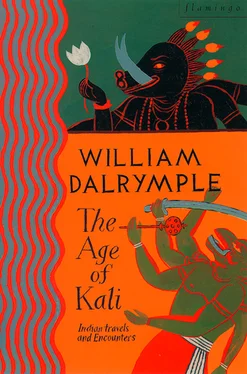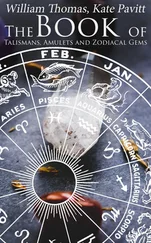Devout Hindus believe that Krishna is still present in this temple town with its crumbling palaces and swarming ashrams , its open sewers and its stalls selling brightly coloured lithographs of the God Child. Listen carefully in Vrindavan, I was told by an old sadhu (holy man) on the riverbank, for if you are attentive you can still catch the distant strains of Krishna’s flute. In the morning, said the sadhu , the god can sometimes be glimpsed bathing at the ghats ; while in the evening he is often seen walking with Radha along the bank of the Jumna.
Every year, hundreds of thousands of Hindu devotees come to Vrindavan, making their way barefoot to the Jumna along the parikrama which links all the town’s most holy temples and shrines. Most then head on to another neighbouring pilgrimage site: the mountain of Govardhan, which, according to legend, Krishna used as an umbrella, lifting it with his little finger. It is now not much more than a hillock, but this does not worry the pilgrims; they know the legend that the more sin proliferates in the world, the more the mountain is diminished.
Some who come to Vrindavan, however, never leave the town again. For many Hindus believe that there is nowhere more holy in all India, and therefore that there is nowhere better to spend your final days, nowhere better to prepare for death.
The pilgrims come from many different castes and communities, from amongst the rich and the poor, from the north and south; but one group in particular predominates: the widows. You notice them the minute you arrive in Vrindavan, bent-backed and white-saried, with their shaven heads and outstretched begging-bowls; on their foreheads they wear the tuning-fork-shaped ash-smear that marks them out as disciples of Krishna. Some of them have slipped out of their homes and left their families, feeling themselves becoming an encumbrance; others have fled vindictive sons and daughters-in-law. Most have simply been thrown out of their houses. For in traditional Hindu society, a woman loses all her status the minute her husband dies. She is forbidden to wear colours or jewellery or to eat meat. She is forbidden to remarry (at least if she is of reasonably high caste; low-caste and Untouchable women can do what they want) and she is forbidden to own property. She may no longer be expected to commit sati and throw herself on her husband’s funeral pyre, but in many traditional communities, particularly in the more remote villages, she is still expected to shave her head and live like an ascetic, sleeping on the ground, living only to fast and pray for her departed spouse.
This practice receives a certain legitimacy in the ancient Hindu tradition that old people who have seen the birth of their grandchildren should disappear off in to the forest and spend their last days in prayer, pilgrimage and fasting. In modern India the custom has largely died out, but in some parts, notably rural Bengal, a form of it has survived that involves simply kicking bereaved grandmothers out of their houses and sending them off to the City of Widows.
Every day widows from all over India arrive in Vrindavan. They come to seek the protection of Krishna, to chant mantras and to meditate on their own mortality. They live in great poverty. In return for four hours of chanting, the principal ashram will give a widow a cupful of rice and two rupees – about four pence. Otherwise the old women, a surprising number of them from relatively wealthy, high-caste, landowning families, subsist on what they can beg. They have no privacy, no luxuries, no holidays. They simply pray until they keel over and die. There are eight thousand of them at present in the town, and every year their number increases.
‘If I were to sit under a tree,’ said Kamala Ghosh, a local women’s rights activist, ‘and tell you the sadness of the widows of Vrindavan, the leaves of that tree would fall like tears.’
‘My husband died when I was seventeen years old,’ said Kanaklatha. ‘He had some sort of stomach disorder. I took him to lots of hospitals in Calcutta but he did not recover. He suffered for a month. Then he died.’
The old lady looked past me, her clouded eyes focused towards the ghats and the course of the holy river Jumna.
‘I still remember his face when they brought him to me,’ she said. ‘He was very fair, with fine, sharp features. When he was alive his eyes were unusually large, but now they were closed: he looked as if he was sleeping. Then they took him away. He was a landlord in our village, and greatly respected. But we had no children, and when he died his land was usurped by the village strongmen. I was left with nothing.
‘For two years I stayed where I was. Then I was forced to go to Calcutta to work as a maid. I wasn’t used to working as a servant, and every day I cried. I asked Govinda [Krishna], “What have I done to deserve this?” How can I describe to anyone how great my pain was? After three years Krishna appeared to me in a dream and said that I should come here. That was 1955. I’ve been here forty years now.’
‘Do you never feel like going back?’
‘Never! After my husband died and they took away everything I owned, I vowed never to look at my village again. I will never go back.’
We were standing in the main bazaar of Vrindavan. Rickshaws were rattling past us along the rutted roads, past the tethered buffaloes and the clouds of bees swarming outside the sweet shops. Behind us rose the portico of the Shri Bhagwan Bhajan ashram . Through its door came the sound of bells and clashing cymbals and the constant rising, falling eddy of the widows’ incessant chant: ‘ Hare Ram, Hare Krishna, Hare Ram, Hare Krishna … ’ Occasionally, above the chant of two thousand women, you could hear snatches of the soaring Bengali verses of the lead singer:
Mare Keshto rakhe ke?
Rakhe Keshto mare ke?
Whom Krishna destroys, who can save?
Whom he saves, who can destroy?
It was ten in the morning and Kanaklatha had just finished her four-hour shift. In her hand she held her reward: a knotted cloth containing a single cupful of rice and her two rupees. ‘We try to remember what we are chanting,’ said Kanaklatha, following my gaze, ‘but mostly we carry on so that we can eat. When we fall ill and cannot chant, the ashram doesn’t help: we just go hungry.’
Kanaklatha said she had got up at four thirty, as she did every day. She had bathed and dressed her Krishna idol, spent an hour in prayer before it, then performed her ablutions at the ghat . Then from six until ten she chanted her mantras at the ashram . After that, a day of begging in the bazaars of Vrindavan stretched ahead.
‘I stay with my mother,’ said Kanaklatha. ‘She is ninety-five. My father died when I was sixteen and she came here then. We have to pay a hundred rupees [£2] rent a month. It is my main worry in life. Now I’m two months in arrears. Every day I ask Govinda to help us make ends meet. I know he will look after us.’
‘How can you believe that after all you’ve been through?’
‘If Govinda doesn’t look after us who will?’ said Kanaklatha. ‘If I didn’t believe in him how could I stay alive?’
The widow looked straight at me: ‘All I want is to serve him,’ she insisted. ‘Whatever we eat and drink is his gift. Without him we would have nothing. The way he wants things to be, that is how they are.’
‘Come,’ she said, her face lighting up. ‘Come and see my image of Govinda. He is so beautiful.’
Without waiting to see if I would follow, the old lady hobbled away along the street at a surprising pace. She led me through a labyrinth of lanes and alleys, past roadside shrines and brightly-lit temples, until eventually we reached a small courtyard house near the ghats . There, on the floor of a cramped, dark, airless room, lay Kanaklatha’s mother. She was shaven-headed and smeared with ash like her daughter, but she was toothless and shrunken, lying curled up like an embryo on a thin cotton sheet. Around her were scattered a few pots and pans. Kanaklatha squatted on the floor beside her and gently stroked her head.
Читать дальше












